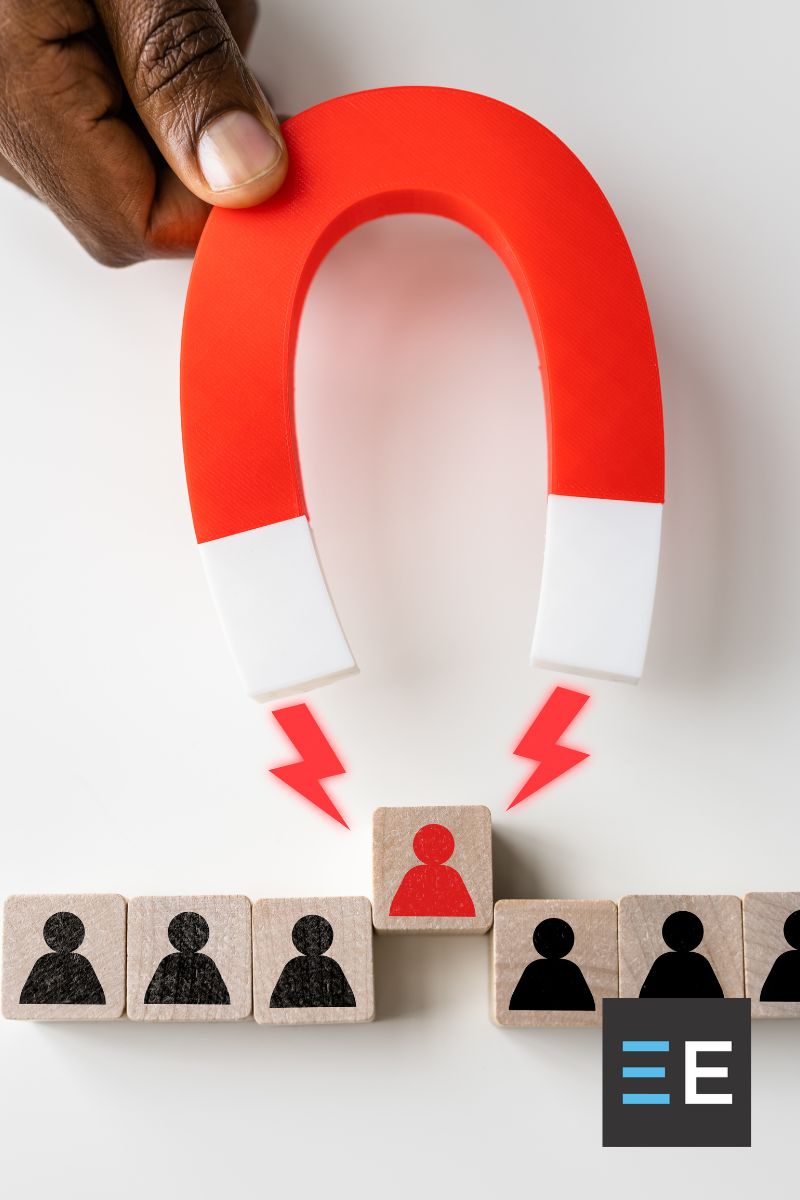Crafting the perfect lead magnet is an important aspect of content marketing. It serves as the crown jewel that entices customers and converts them into leads. In this guide, we will walk you through the process of creating content offers that will leave your audience eager to join your mailing list.
The Importance of Lead Magnets
Before delving into the details of crafting the perfect lead magnet, it’s essential to grasp why a lead magnet holds such significance in the world of content marketing.
Lead magnets are what they sound like: content designed to generate leads. They entice visitors to provide their contact information in exchange for content, and this information can then be used to nurture and convert visitors into paying customers.
Lead magnets also establish you as a source of valuable information. This in turn increases the likelihood of your audience seeking guidance from you in the future.
With lead magnets, segmenting and personalizing your audience becomes easier. By using them, you can tailor your content offers to match your audience’s interests and needs. This personalization greatly boosts the chances of conversion.
Now that we understand the significance, let’s dive into the steps for crafting the perfect lead magnet.
Step 1: Gain In-depth Knowledge About Your Audience
Crafting content offers begins with an understanding of your target audience. It is crucial to understand their pain points, desires, and interests. Conduct market research, analyze customer data, and create customer personas. Consider factors like demographics (such as age, gender, location, and occupation) and psychographics (such as interests, values, and lifestyle choices) when delving into your audience’s profile.
When doing your research, consider the following components:
Online behavior. How does your audience engage with content? Are they active on social media? Do they prefer consuming videos, written articles, or other visual content?
Pain points. Which pain points can your lead magnet help solve? What solutions is your audience actively seeking?
Buying stage. Determine where your audience is in the buyer’s journey. Are they browsing, considering options, or ready to make a decision?
Understanding your audience is akin to possessing a map leading to their thoughts and desires. It serves as the foundation for crafting the perfect lead magnet that truly resonates with them.
Step 2: Select the Ideal Lead Magnet Type
After gaining insights into your audience, it’s time to select the type of lead magnet that aligns with their needs and preferences. Here are some popular lead magnet options worth considering:
- E-books and Whitepapers: Comprehensive reports offering information and insights.
- Checklists and cheat sheets: Practical resources that simplify processes.
- Templates and tools: Anything from budget spreadsheets to social media content calendars.
- Webinars and video guides: Live or prerecorded sessions that offer knowledge and address challenges.
- Email courses: A series of informational emails delivered over time.
- Assessments: Interactive tools that help your audience gain insights about themselves.
- Exclusive access: Access to premium content, a community, or early product releases.
- Promotions: Special coupons for your products or services.
When selecting a lead magnet, it’s important to consider your audience’s preferences and the problems you aim to solve. For example, if you cater to a design audience who enjoys videos, a video tutorial on a popular design software tool can be an excellent lead magnet choice.
Step 3: Create Valuable Content
Ensure that your lead magnet showcases your expertise and commitment to delivering value by following these tips:
- Do thorough research. Dive into your topic to provide insights and solutions that are not easily found elsewhere.
- Create an engaging design. Pay attention to the appeal of your content. If your free resource or incentive lacks appeal, it may discourage leads from engaging with it.
- Keep it simple. Make sure your content is easy to comprehend and digest. Avoid using jargon or complex language that could alienate your audience.
- Encourage Action. Your free resource should empower readers to take action or apply the knowledge they have acquired.
- Pay attention to details. Look out for typos and grammatical errors, which can undermine your credibility. Take the time to proofread meticulously.
- Ensure brand consistency. For a visual identity, keep your brand consistent in elements such as colors, logo, and typography.
Remember, your lead magnet serves as a preview of the quality of content and expertise you offer, so make it count!
Step 4: Craft an Engaging Headline and Copy
The headline and copy of your lead magnet are like the bait on a fishing hook. They need to capture your audience’s attention and compel them to take action. Here are a few tips for creating an engaging headline and copy:
- Clearly communicate value. Ensure that your headline and copy clearly communicate what the free resource offers and how it will benefit the reader.
- Highlight benefits. Focus on the benefits that your audience will gain by downloading or accessing the resource. What issues will it address for them?
- Use persuasive language. Incorporate techniques such as highlighting scarcity, creating a sense of urgency, and showcasing proof when applicable.
- Be succinct. Keep the copy concise and straight to the point. Lengthy text can lead to a loss of interest from the reader.
- Test and refine. Use A/B testing to refine your headlines and copy in order to optimize conversions.
- Use mobile-friendly practices. Ensure that your copy is easily readable on devices, because many users access content through their smartphones.
Step 5: Enhance Landing Pages
Your landing page acts as the entry point for your lead magnet. It’s where visitors make the decision to provide their contact information in exchange for your content offer. To enhance your landing page, follow these tips:
- Eliminate distractions. Keep the page clean and free from any distracting links or navigation elements.
- Simplify forms. Request only necessary information from users, such as an email address and possibly a first name. Lengthy forms can discourage sign-ups.
- Use visual hierarchy. Use design principles to guide the visitor’s attention toward the call-to-action (CTA) button.
- Show social proof. Showcase reviews, testimonials, or statistical data to establish trustworthiness.
- Make the CTA noticeable. Ensure that the CTA button stands out and is strategically positioned.
- Optimize for mobile. Make certain that the landing page appears and functions on mobile devices.
Step 6: Promote Your Lead Magnet
Crafting the perfect lead magnet is one part of the equation; you must also effectively promote it to attract your intended audience. Here are some strategies for promotion:
- Social media: Share teasers and snippets across your social media platforms, accompanied by a link to the landing page.
- Email marketing: Publicize your lead magnet among your existing email subscribers.
- Guest blogging: Contribute guest posts to websites and incorporate a link to your lead magnet in your author bio.
- Collaborations: Collaborate with influencers or businesses that complement yours in order to promote your lead magnet within their audience.
- Traditional advertisements: Consider running paid advertisements on platforms like Facebook and Google to generate traffic for your landing page.
- Internal links: Enhance your blog posts by including a link to your lead magnet, targeting readers who are already interested in your content.
- Webinars: If you are doing webinars or have speaking engagements, take a second to mention your lead magnet.
Remember that consistency is key when it comes to promotion. Don’t just promote your lead magnet once and forget about it. Develop a thought-out promotion plan and continue spreading the word.
Step 7: Measure and Optimize
Once you’ve released your lead magnet into the world, it’s crucial to assess its performance and make improvements. Some important metrics to track include the following:
- Conversion rate: How many visitors who land on your page actually sign up for the lead magnet?
- Click-through rate (CTR): How many people who come across your promotion actually click through to the landing page?
- Bounce rate: The percentage of visitors who leave the landing page without taking any action.
- Engagement: If you have touchpoints in your lead magnet, it’s important to keep track of how engaged your leads are with the content.
- Lead quality: Take a look at the leads generated by your lead magnet. Are they genuinely interested in what you have to offer?
Make use of analytics tools and A/B testing to collect data and insights that will help you continually refine your lead magnet and promotional efforts.
Conclusion
Crafting the perfect lead magnet is an important skill for content marketers and writers alike. It serves as a gateway to building an audience and converting visitors into leads. By understanding your target audience, you can develop lead magnets that not only attract but also nurture and convert your audience. Remember that creating the lead magnet is the beginning, and marketing yourself is a process of improvement and optimization. So, go create that lead magnet and witness the growth of your business.








